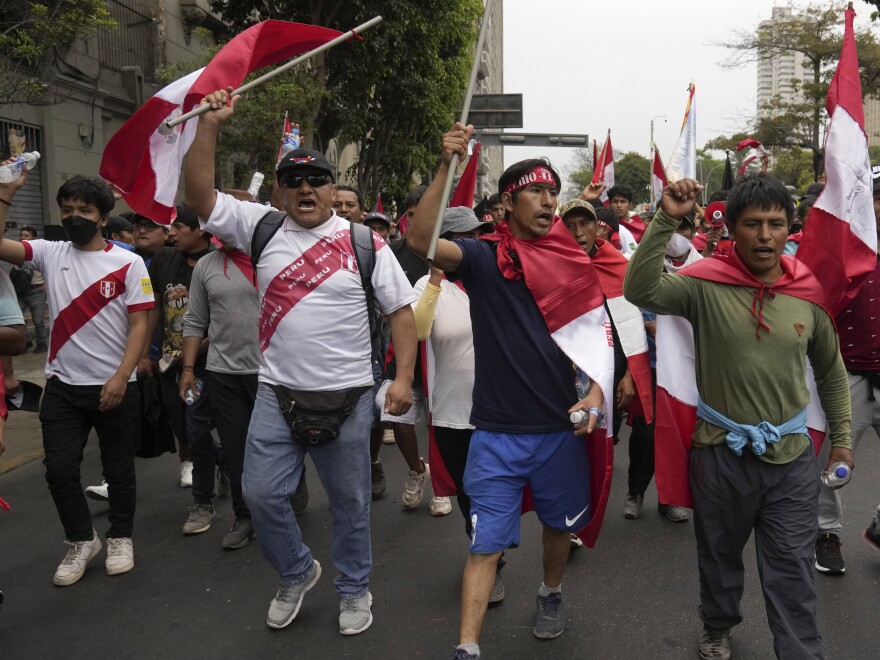Updated January 19, 2023 at 4:16 PM ET
LIMA, Peru — Peru's capital is bracing for large demonstrations against the government over coming days. Thousands of rural residents have been streaming into Lima to demand justice for the more than 50 people killed in weeks of protests.
Demonstrators began blocking roads and storming airports around the country after the arrest and impeachment of former President Pedro Castillo last month. The political newcomer was facing a third impeachment attempt and prior to the vote, attempted to dissolve Congress and rule by decree.
His vice president, Dina Boluarte, was sworn in immediately following Castillo's jailing.
What the demonstrators are demanding
Demonstrators want Boluarte to resign and for new elections to be held. She has imposed a state of emergency in the capital Lima and three other regions.
What began as protests demanding the release and restitution of Castillo have morphed into widespread calls for justice for those killed by what activists say is excessive force by police and the military.

Protesters also want to bring attention to long-standing social and economic inequality in the country. The wealth gap between Peru's indigenous south and the urban capital has long been present, but has widened in recent years.
Dina Lopez came to Lima from her highland city of Ayacucho to participate in protests. "No one pays attention to us out there — where are our human rights?" she said. She spoke to NPR as police attempted to remove her and fellow protesters from the doorsteps of a church.
"That woman is deaf to our suffering," Lopez added, referring to President Boluarte.
For her part, Boluarte says she is not leaving. "These necessities will be resolved, only when we get together and converse pacifically," she said while attending the opening session of Peru's Constitutional Court on Tuesday.
She said the historic needs of Peru's poor and indigenous communities can't be addressed through violence.
There are fears of escalating and prolonged violence
The divide between Peru's Lima elite and the rest of the country is nothing new, but these prolonged protests are unusual, Alberto Vergara, a political scientist at Lima's Pacific University, told NPR.
"Now we have 50 dead and we are on a path to have more," he warns. Vergara fears that given Peru's dysfunctional political system more violence is inevitable.
Indeed, Peru has had 10 presidents in more than 20 years of political upheaval, with one leader lasting just six days.
Vergara said Peru's mediocre politicians are the threat here — not tyranny which usually leads to democratic demise. "Peru is perhaps showing us that chaos and disorder can also be the opposite of democracy," he said.
Security services are accused of excessive force
Conservatives, including Congressman Jorge Montoya, warn of possible terrorism links to the ongoing demonstrations and unrest. He claims, without evidence, that the marchers are backed by communists and drug traffickers.

"There is no dialogue, no dialogue is necessary. What is necessary is to correct what is wrong," Montoya told NPR. He is calling for a strong hand by security forces to end the demonstrations, and even says it was the protesters who shot at civilians during demonstrators.
Human rights lawyer Juan Miguel Jugo says that is absurd. "There is no proof that happened," he told NPR. He said the deaths were caused by excessive force by the police that shot civilians in the head, chest and limbs.
Protesters say they will continue marching until the president and Congress are gone and new elections are scheduled for this year. One woman, who would only give NPR her first name, Tanya, for fear of government retaliation, said she will not be backing down.
"Our eyes have been opened and we will continue fighting," she said.
Copyright 2024 NPR. To see more, visit https://www.npr.org.




